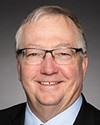I certainly can.
In terms of fuel resupply, we tend to err on the side of having extra as opposed to having less. As a utility, we haven't run short. It's a little complicated in Nunavut, because we don't have bulk storage in all of our communities, so we rely on the petroleum products division of the Government of Nunavut to store some of our fuel. We will work through them, nominate the amount of fuel we want them to purchase for us, and they'll purchase and store it for us, and pay us as they deliver it.
Certainly some communities have run out, not because they were unable to determine the correct amount but because of late resupply, because of ice breakups being late, or the resupply ship coming in late. We recognize that some communities are going to run out of fuel. An airplane with fuel bladders flies in and tides them over until the resupply ship is able to get in.



